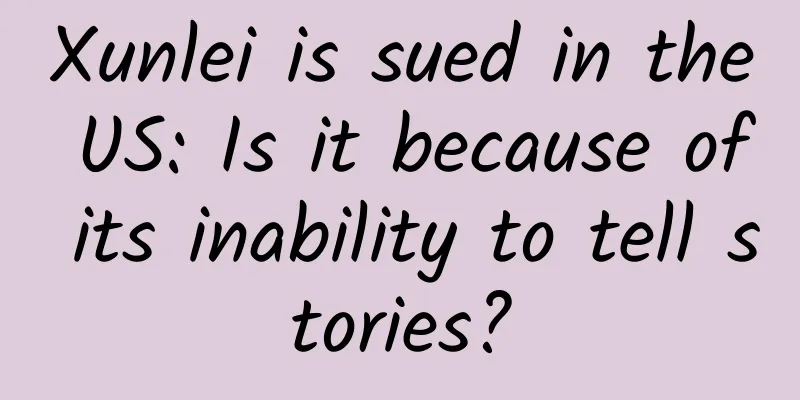Xunlei is sued in the US: Is it because of its inability to tell stories?

|
The hot summer of June 2015 is about to pass, and in the past twenty days or so, Chinese listed companies have continuously performed one hot topic and wonderful story after another in the domestic and overseas capital markets: On June 5, after a lapse of 7 years and 9 months, the Shanghai Composite Index re-stood above 5,000 points, and the trading volume of the two markets exceeded 2 trillion; On June 10, the unlisted Xiaomi and the listed LeTV in China began an open fight that has lasted to this day; On June 17, Qihoo announced its privatization, and on the same day, Hongda New Materials, which Focus Media planned to use as a shell company to go public in China, was investigated by the China Securities Regulatory Commission, and the topic of the return of Chinese companies to privatization was once again hotly discussed; On June 19, the Shanghai Composite Index plummeted 6.42%, falling below 4,500 points, creating a "Dragon Boat Festival disaster"; On June 23, Professor Liu Shuwei released the analysis report on LeTV as scheduled, pointing out that the "burning money" model was difficult to sustain and LeTV was once again at the center of the storm. In the domestic capital market this month, which has experienced frequent ups and downs and constant shocks, there are two hot topics: one is the return of Chinese concept stocks, and the other is how to reasonably consider the valuation and "money-burning model" of high-tech "concept" ("story") companies. Also in June, the class action lawsuit against Xunlei, a Chinese concept company listed in the United States, is closely related to the above two hot topics. Xunlei became the second Chinese concept company to encounter a class action lawsuit this month and the ninth this year. Next, the author will discuss and analyze the basic situation of this lawsuit and how to consider the topic of "storytelling" companies. Transformation after listing, urgently need a new story? In 2011, Xunlei first impacted IPO, and its valuation once reached 2 billion US dollars. Later, due to the "Chinese concept stock turmoil", it had to postpone the IPO. On June 24, 2014, Xunlei officially went public in the United States. This IPO issued a total of 8.41225 million ADSs (each ADS represents 5 common shares), each RDS was $12, and the total issuance income was $100.947 million. After deducting $7.066 million in underwriting fees and $3.504 million in accounting and lawyer fees, the net issuance income was $90.377 million. Xunlei had completed five rounds of financing before this listing, with a total financing scale of more than $500 million. Among them, the financing in April 2014 alone was $310 million. In the past 52 weeks, Xunlei's stock price ranged from $5.93 to $16.18; the stock closed at $13.68 on June 24, 2015, with a total market value of $943 million; and the cash balance was close to $390 million on March 31, 2015. The above information seems to indicate: a. Compared with the $500 million in financing before the IPO, Xunlei's US IPO financing amount is not high; b. Considering Xunlei's current cash balance, the current market value of more than $900 million does not seem high; but if we combine the relevant financial data of Xunlei shown in the following table, we will find that: Xunlei's performance in each quarter before its IPO in June 2014 showed an upward trend, but after the IPO, its performance obviously declined on a large scale, especially in the fourth quarter of 2014, when its revenue declined sharply from the previous quarter, and in the first quarter of 2015, it suffered a serious loss. Therefore, if Xunlei's IPO time is slightly delayed, due to poor performance after the period, it is very likely to have a negative impact on the IPO. From this perspective, Xunlei's IPO team was still very successful in grasping the timing of the IPO. On March 31, 2015, Xunlei announced that it would sell its shares in Xunlei Kankan to Beijing Xiangchao International Media Co., Ltd. for 130 million yuan. Xunlei said that this was to divest "non-core and unprofitable" businesses while ensuring the strategic execution of mobile business and "Crystal Project". Some media pointed out that the abandonment of Xunlei Kankan means a comprehensive transformation of Xunlei's company strategy. In other words, Xunlei wants to tell another story. But unexpectedly, this new story has not been told for long, but it has attracted a lot of "lawsuits". Class action lawsuit: Is it all caused by the "beautiful story"? After the stock market closed on May 20, 2015 (Eastern Time), Xunlei announced its first quarter results as of March 31, 2015: first quarter revenue was US$30.2 million, down 8.4% year-on-year and 14.9% month-on-month; net profit was US$2.4 million, down 47.8% year-on-year and 66.7% month-on-month; due to the decline in the number of subscribers (the number of subscribers fell from 4.95 million on December 31, 2014 to 4.88 million on March 31, 2015), Xunlei's core business subscription service revenue continued to decline; Xunlei's first quarter subscription service revenue was US$21.2 million, down 8.5% year-on-year and 14.7% month-on-month. By the close of May 21, 2015, Xunlei's stock price fell by $1.69 to $9.71, a drop of 15%. On June 8, 2015, a class action lawsuit broke out, with the plaintiffs accusing Xunlei of publishing false and misleading information and failing to disclose the significant risks that the Crystal Project and mobile strategy could have on the company's financial condition; the lawsuit lasted from June 24, 2014 (the effective date of the company's IPO prospectus) to May 20, 2015 (the announcement date of the first quarter results of 2015). The defendants include: Xunlei Company, its CEO and CFO ("individual defendants"), and investment bank defendants including JPMorgan Chase, Citigroup and Oppenheimer. The plaintiff pointed out: l All of the above defendants violated Section 10(b) of the Securities Exchange Act and Rule 10b-5 of the SEC. This allegation must meet the fraud (scienter) condition, which is estimated to be difficult to prove; l The two individual defendants violated Section 20(a) of the Securities Exchange Act, namely, the controller liability clause; the success of this allegation depends largely on whether the previous allegation is established; l The two individual defendants violated Section 11 of the Securities Act. This allegation is mainly aimed at the alleged misleading content in the prospectus; l All defendants violated Section 12(a)(2) of the Securities Act. This allegation is aimed at the content of the prospectus and does not need to meet the fraud condition; l The individual defendants violated Section 12 of the Securities Act, the controller liability clause. Whether this allegation is established depends mainly on whether the previous allegation is successful. In paragraph 28 of the complaint, the plaintiff cited the speech of Xunlei's senior executives in the earnings announcement conference call on August 21, 2014, pointing out that Xunlei had conducted beta testing of the "Crystal Project" in April 2014 and had made significant progress. In addition, Xunlei claimed that its "Crystal Project" was very optimistic about reducing the company's bandwidth costs in the future because the technology could increase bandwidth by nine or ten times; Xunlei also claimed that Xiaomi would likely be the first paying customer of the "Crystal Project"; but at the same time, Xunlei's senior executives also pointed out that the "Crystal Project" is still in its early stages and the company will announce to the market if there is more substantive information or progress. The plaintiff pointed out that this was the first time that Xunlei disclosed to investors that it had been carrying out the "Crystal Project". Previously, the company's prospectus that took effect on June 24, 2014 did not disclose this project. The plaintiff believes that Xunlei's above-mentioned external information disclosure is materially misleading because Xunlei did not disclose the risk that its business strategy transformation to the "Crystal Project" and mobile business would have an adverse impact on the company's financial condition. Judging from the complaint, it is still difficult for the plaintiff to successfully accuse. Xunlei did not disclose the risks related to its "Crystal Project" and mobile business; however, as disclosed by Xunlei executives at the quarterly performance announcement meeting, the "Crystal Project" is still in its early stages. Whether it needs to be disclosed to the public, and why it would constitute a major misrepresentation or omission of major information if it is not disclosed, the plaintiff did not point out the specific reasons, so from this point of view, the plaintiff's accusation is not strong. As for the mobile business, this is even more so, because the plaintiff did not point out why Xunlei needed to disclose information related to this business and when it started. In addition, the plaintiff pointed out that Xunlei sold "Xunlei Kankan" to improve the company's financial situation (see paragraph 31 of the complaint), which seems to be an attempt to point out that Xunlei did not disclose the risk of adverse effects on the company's financial situation when transforming its business to the "Crystal Project" and mobile business. The plaintiff's accusation has certain logical flaws, because it is not the business transformation that causes the company's financial situation to be at risk, but if there is no transformation, the company's financial situation will really be at risk; that is to say, business transformation is not the reason for the company's financial situation to be at risk, and the company's financial risks are not caused by the "Crystal Project" or the mobile business (at least the plaintiff has not pointed out so at present), and the real "culprit" that causes the company's financial situation to be at risk is the traditional business such as "Thunder Kankan", and the plaintiff did not accuse the company of any inappropriate information disclosure on the traditional online business "Thunder Kankan". Of course, the plaintiff can also point out that what he accused is not just that Xunlei did not disclose the risks related to the "Crystal Project" and the mobile business, but that Xunlei did not disclose the risks of business transformation. But even so, the plaintiff's accusation is not strong enough, because the plaintiff did not point out when Xunlei's business began to substantially transform, was it before Xunlei's IPO? Because this will directly involve the time when Xunlei began to have the obligation to disclose the information to the outside world, which the plaintiff did not point out. On the contrary, Xunlei can argue that the substantial step of its business transformation is to sell "Xunlei Kankan", and Xunlei fully disclosed this sale transaction at the first time. In addition, the plaintiff may also point out that the trend of users of Xunlei or other similar Internet companies from traditional PC online to mobile terminals is obvious, so it is necessary to conduct risk assessment on mobile business. For example, when Facebook went public, the SEC required it to disclose risks in order to avoid misleading investors. However, judging from the current draft of the lawsuit, the plaintiff did not make such an accusation, and the outside world has no way of knowing whether Xunlei's own business existed at the time of IPO. Therefore, it is not easy to accuse. In short, the Xunlei lawsuit involves the information disclosure judgment triggered by the transition stage of the end of the "old story" (Xunlei Kankan's traditional business) and the beginning of the "new story" ("Crystal Project" and mobile business). We look forward to how the plaintiff and the defendant will play the game on this, and the analysis, judgment and ruling process of the judge. For the "litigation stick", it is not interested in how Xunlei should disclose its risks. The "litigation stick" hopes to successfully sue Xunlei and tie Xunlei to the chariot of litigation. If the case can develop to the evidence disclosure procedure, the "litigation stick" will have more bargaining chips to negotiate and obtain compensation. For Chinese companies, the ruling of the Xunlei lawsuit will form a new case law. In the future, when transforming their business or "telling stories", they should pay attention to the information disclosure risks, and they can refer to the Xunlei lawsuit case. Will Xunlei join the privatization and return trend of Chinese companies? The return of Chinese companies is one of the hot topics this year. It is reported that 24 Chinese companies listed in the United States have announced privatization since 2015 and plan to return to the domestic capital market. Among them, several are new companies that were listed in 2014 (such as Momo). In the domestic capital market, the market value of Baofeng Technology and LeTV, which are not large in size, exceeds 30 billion yuan and 100 billion yuan respectively, which naturally makes Youku Tudou and Xunlei, which are listed in the United States, extremely envious. On June 24, 2015, on the first anniversary of Xunlei's listing, Xunlei's CEO posted a microblog to talk about privatization, pointing out that we should not blindly follow the trend, and pointed out that privatization should consider two issues: 1. What can we gain if we return to the A-share market? 2. What might we lose if we do not return to the A-share market? When returning to the domestic capital market through privatization, legal, financial and tax professional and technical issues such as funds, dismantling of VIE structure, and exit of US dollar shareholders will be involved, as well as unpredictable issues such as the overall performance of the domestic capital market and the time it takes to queue for listing. Therefore, it is not an easy task for all companies, and the risks hidden in this process are not something that all companies can afford. However, whether in the US capital market or the Chinese capital market, the health of the business of the enterprise is a prerequisite. If there are problems with the business model and the business growth is weak, then even if you rely on telling a beautiful story, you can only gain short-term favor from the capital market at most. And whether encountering a class action lawsuit in the United States will affect the privatization process and A-share listing depends on the specific reasons for the lawsuit. How to consider the concept company of "storytelling"? At present, concept companies that can tell stories are very popular in the domestic and foreign capital markets. For example, some are called "Internet thinking", some are called "ecosystem", "ecosphere", "ecological chain", "sub-ecosystem", etc. These innovative companies are often pioneers in promoting human development, but at the same time, some will bring temptations to investors, and some may become traps. Some people believe that the static and dynamic price-earnings ratio and price-to-book ratio applicable to the valuation of traditional industries may not be suitable for these companies, and even the price-to-sales ratio may not be suitable for these companies. Then, can investors only use the "price-dream ratio" to fantasize about the valuation of these companies? How should investors consider these concept companies? Are the valuations of these companies reasonable? Are these companies worth continuing to burn money? The author believes that considering these companies requires starting from two aspects of market system construction. On the one hand, listed companies need to fully disclose the key information of the "story" they tell from the perspective of investor needs; on the other hand, it is necessary and allowed to conduct public and comprehensive evaluation and supervision of the disclosure quality of the story to ensure that the disclosure is of high quality and has substantive significance for investors. Fully disclose the key information of the story. Fully disclosing the key information of the story includes two meanings. The first is that the specific risks of the story need to be disclosed. It is not enough to disclose only the beautiful side of the story. The specific risks implied in it also need to be disclosed, and it cannot be generalized, let alone concealing certain risks. Companies that promote the concept of "ecosystem" need to tell investors where the key factors will be if each of its sub-ecosystems is successful? Where are the specific risks? What is the current development trend of each sub-ecosystem? Since each company has different concepts and their stories have different beauties, their respective risks should also be different, so this risk disclosure should not be the same. The second is the need for quantitative assessment data. For innovative high-tech companies and Internet companies, in the early stage or market expansion period, if only traditional financial indicators (such as gross profit margin, net profit, etc.) are used for valuation, it may be unfair or not meet the needs of investors. Therefore, this article will not discuss how financial data plays a role in considering these companies (please note: this does not mean that financial data cannot play a role); and key operational indicators (key operational metrics) may be more important in the early stage of the story. These operating indicators vary from industry to industry, such as: Tesla's order volume and delivery volume, the number of registered users, active users, actual paying users, ARPU value in the gaming industry, mobile phone shipments in the smartphone industry, TV shipments and renewal users in the smart TV industry, etc. However, these so-called key operating indicators must have a clear and direct relationship with the profitability of the enterprise, and cannot be merely superficial (such as only a single indicator of market share), and cannot be indicators (or single indicators) that are only used to induce investors' imagination. For example: the number of actual paying users in the gaming industry is more relevant than the number of registered users, so only the latter cannot be disclosed without the former. For another example, if a video website only discloses the cumulative playback time of its video ads without disclosing the ARPU value, it may mislead investors. Investors need to consider concept companies by continuously tracking these key operating indicators, so these indicators should not mislead and confuse investors. In November 2013, Ms. White, chairman of the US SEC, publicly pointed out at a conference that the number of users of technology companies may have nothing to do with profits, and she warned investors not to be confused by the attractive number of users. The SEC is concerned about whether the logical relationship between these so-called operating indicators and the company's profitability is clear; because if this logical relationship is not strong, or the company does not disclose it clearly, it may mislead investors. When Internet companies such as GROUPON, FACEBOOK, and TWITTER went public, the SEC required them to disclose relevant non-standard operating indicators and risks more clearly and in detail. Therefore, companies that promote ecological and Internet concepts need to disclose their key operating indicators to investors, and these indicators must be directly and obviously related to profitability and cannot be misleading. In other words, for investors, these indicators must be relevant and non-misleading. Public and comprehensive evaluation and supervision of the disclosure quality of stories Another aspect of the system construction is the need and permission for public and comprehensive evaluation and supervision of the disclosure quality of the stories told. For example, are the risks disclosed by listed companies sufficient? Are certain risks concealed? Are the key operating indicators disclosed by listed companies reasonable? Are they directly related to profitability? Will they mislead investors? Public and comprehensive supervision, including supervision from regulatory authorities and the public. The Corporate Finance Division of the US SEC has a disclosure review team of about 400 people. These 400 professionals are responsible for reviewing the prospectuses, annual reports, quarterly reports, and interim announcements of about 5,000 US listed companies. During the review process, they have thousands of written communications with listed companies every year, and these communications are public and can be obtained from the SEC website. The responsibility of these disclosure review experts is to ensure that the information disclosed by listed companies is valuable and relevant to investors, and not misleading. Supervision from the public is also very important, so it should be encouraged. For example, Professor Liu Shuwei's analysis report on LeTV this month, the analysis reports of various professional investment institutions, and the shareholder class action lawsuit in this case are all manifestations of the power of supervision from the public. If we establish the above system and ensure its effective operation, then no matter what "concept" a listed company launches or what "story" it tells, is it burning money? Where is the money burned? How long can it burn? How long is it allowed to burn? These questions are no longer problems, because investors can make their own judgments and investment decisions based on useful, reliable, and non-misleading information. For investors, the stock market is risky and investors need to be cautious when entering the market. Similarly, for listed companies that are only good at "storytelling", stories are risky and investors need to be cautious when burning money. Regardless of whether the current bull market is a policy bull market, a capital bull market or a reform bull market, if we add some elements such as a regulatory bull market and a transparent bull market, we may be able to generate more innovative bull markets and long-lasting business bull markets. Only in this way can we cherish the current bull market, which is not easy to come by, and make the current bull market last longer and further. As a winner of Toutiao's Qingyun Plan and Baijiahao's Bai+ Plan, the 2019 Baidu Digital Author of the Year, the Baijiahao's Most Popular Author in the Technology Field, the 2019 Sogou Technology and Culture Author, and the 2021 Baijiahao Quarterly Influential Creator, he has won many awards, including the 2013 Sohu Best Industry Media Person, the 2015 China New Media Entrepreneurship Competition Beijing Third Place, the 2015 Guangmang Experience Award, the 2015 China New Media Entrepreneurship Competition Finals Third Place, and the 2018 Baidu Dynamic Annual Powerful Celebrity. |
<<: Didi Kuaidi’s valuation reaches US$15 billion. Is this a capital game or a reflection of value?
>>: Analysis of the Ultimate Pattern of Television Internetization
Recommend
Jietuo D2308U Mini PC Review
Giada D2308U is an upgraded version of D2308. Alth...
To be honest, you may really not understand much about eating staple foods!
As the saying goes, "Food is the first neces...
Konka portable projector L1 review: a "pocket cinema" for only 1,000 yuan
I believe that many people have a home theater dr...
Uncover the 4 core algorithms behind Tik Tok to help you easily become popular
On TikTok , being on the hot recommendations is t...
Be careful! If you see them, show zero tolerance!
Recently, the alligator gar in Ruzhou, Henan Prov...
How much does it cost to join a fitness app in Zhucheng?
How much does it cost to join a fitness app in Zh...
Surprise! Forehead wrinkles are related to cardiovascular disease?
Have you ever looked in the mirror and suddenly f...
Google launches black technology again: can help goddesses remove mosaics
There is nothing more annoying than having your p...
Why can’t cacti grow in the desert of Xinjiang?
A travel buddy in his 50s told me: There are wild...
Catching up with Tesla, NIO is reportedly planning to develop its own chips
If traditional cars compete with each other in in...
In marketing promotion, how should the market be segmented to be effective?
This chapter expands on the previous overview, ma...
Can you make calls and send text messages on the moon? What problems need to be solved in building a 4G network on the moon?
Recently, Nokia publicly demonstrated for the fir...
Did you know that plants can also be naturalized?
Recent The Men's Basketball World Cup is in f...
Great Wall Motors: In November 2023, Great Wall Motors sold 122,849 vehicles, a year-on-year increase of 40.3%
Great Wall Motors announced its group sales in No...
Do you always charge your battery to 100%? Stop it now.
In today's life, mobile phones are not only a...









